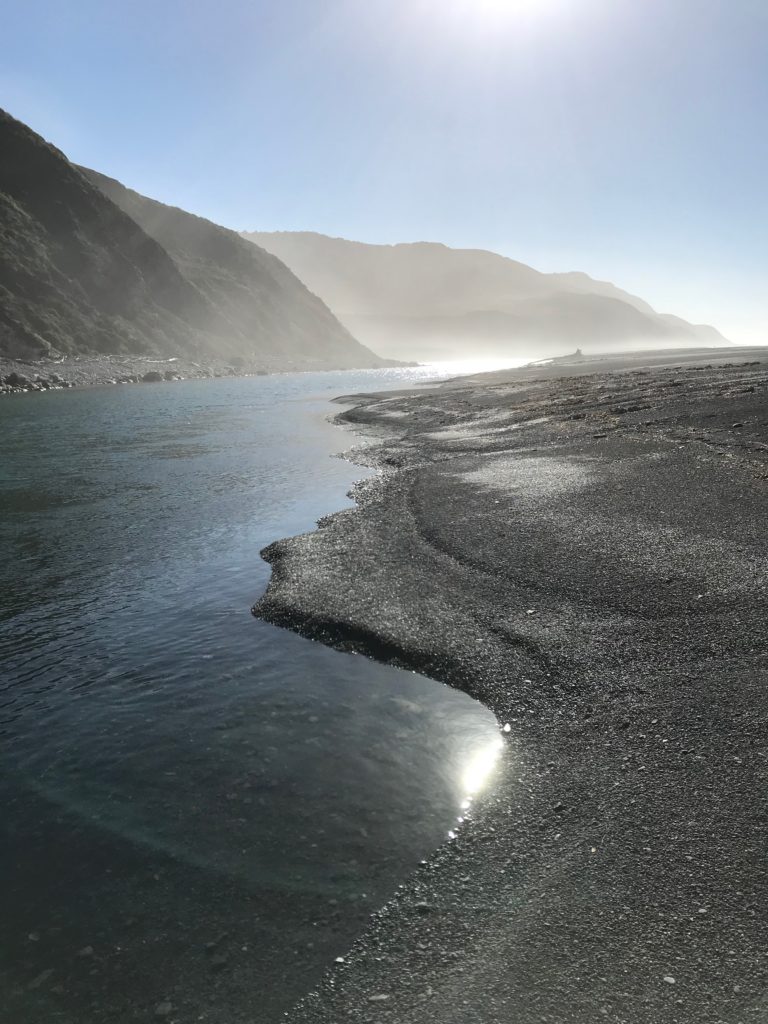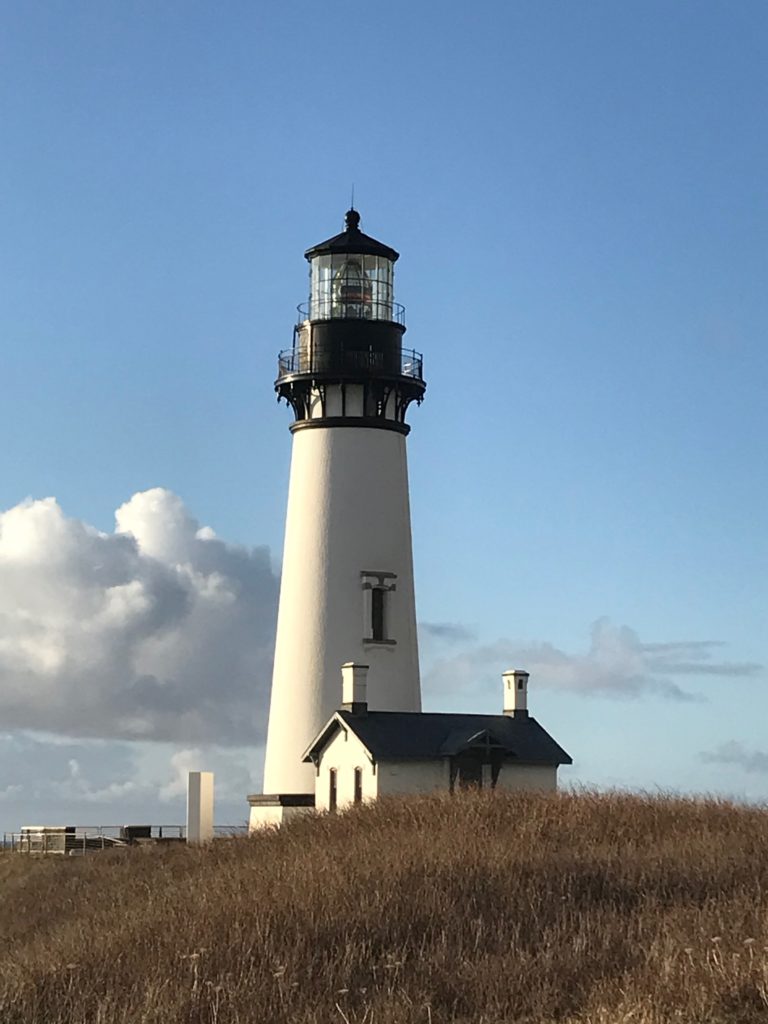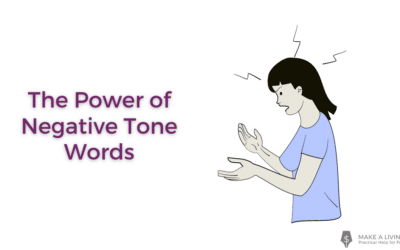Are you a writer who dreams of living the digital nomad lifestyle?
You know-flitting around the globe indulging your travel lust, seeing amazing vistas or visiting the trendiest cities.
While also writing your assignments wherever/whenever you want, working remotely, and still earning what you need to cover the cost of your adventures.
I feel like we’ve all been heavily sold the digital nomad dream.
- How many pictures have you seen on social media of someone with a laptop, blissfully writing on the beach in a hammock?
- Maybe you’ve wondered whether this is a pipe dream, or if you could really make it as a digital nomad.
Well, I bring you a real-life report from the field. After a decade helping other writers live wherever they wanted, I’ve finally become a digital nomad myself!
My husband and I graduated the last kid from high school, bought the RV, and took off to travel in a COVID-safe way. We’ve done several short trips, and are now traveling for at least three months, nonstop.
To be clear, this is not a post about how to squeeze in a little writing time during your vacation-or how to work ahead so you can leave the laptop home and really enjoy your time off. (Got tips for you on those subjects here.)
Digital nomads adopt a lifestyle of fairly constant travel, while we work. In our case, in the first month of our trip alone, we stayed in 19 different places.
All while I continued meeting deadlines for four different writing clients. As I write this, we’re riding out a snowy Seattle winter in sunny Santa Barbara, and loving every minute of it. Here’s an SB sunrise I shot, to give you an idea (all shots in this post by me):

Digital Nomad location: Santa Barbara, Calif.
Obviously, the digital nomad lifestyle has its perks.
But can you really pay your bills with writing, as a constantly-traveling digital nomad?
The answer is yes-but it takes some careful planning and a little creativity.
My tips fall into three basic buckets:
- How to prepare
- How to make traveling cheap so you can keep on rolling
- How to get your work done
Here’s what I’ve learned from my digital-nomad adventures:
Before you go
The success of your digital nomad lifestyle juggling act partly depends on some thoughtful prep before you go-especially if you plan to travel to rural areas with few services.
Big picture: Everything that can go wrong, will.
How can you keep problems that crop up on the road from ruining your writing life? Here are some steps to take before you hit the road:
Line up internet(s)
Obviously, it’s hard to file your story, or do research for a white paper, if you can’t get online. Driving down Highway 1 in California, we saw many beautiful sights, like these mystical haystacks in the tiny town of Elk, Calif.:

Digital Nomad location: Elk, Calif.
The dark side? These sort of towns boast zero phone bars. Many campgrounds also lack wifi. We followed a 3-pronged approach to securing internet access:
- Phone hotspot-if you are in a place with even half-decent phone reception (think two bars), you can usually turn on your smartphone’s personal hotspot and use that for wifi. If you don’t have a smartphone, strongly recommend investing in one if you’re serious about working on the road.
- Location-based wifi-If you’re booking accommodations or campgrounds, know before you go if they offer wifi. Other local resources: Some libraries offer parking-lot wifi, too, that works even when they’re not open. A surprising number of campgrounds now offer wifi, too. The catch: They may be just kidding. We encountered plenty of useless ‘wifi’ in our travels, that didn’t really let us surf the Web, much less stream anything. That’s why you need more than one solution.
- RV-based wifi-For our third option, my hubby got the wifi system that came with our RV up and working (it was non-functioning when we bought it). We set up our WifiRanger to work with AT&T because our phones have a different carrier, so that doubles our odds of success. The Ranger enhances whatever wifi source we’ve chosen, whether it’s AT&T or our location-based wifi, and then IT functions as our hotspot. This booster option often made the difference between no connectivity and getting online.
There are many internet services designed for travelers-here’s a list of good options from Travel & Leisure. Think about the kinds of situations you’ll encounter in your travels. Then, choose and test multiple methods before you leave home.
Setup offline work tools
Ultimately, you’ll probably still encounter times when you simply don’t have internet access.
It’s amazing how fast phone bars drop to zero outside many towns (if you’re wondering why there was so much recent hue-and-cry about the need for the U.S. infrastructure bill).
If you plan to boondock by the roadside between destinations or camp beneath the stars, you may well have no reception. Plan for this reality, and be ready to shift on the fly to work offline.
Sometimes, it’s way less stressful to simply give up on finding internet access. If the muse is upon you and you’re out in the countryside, I recommend giving up on connectivity. Just write offline and upload it to the cloud later. Trust me, it’s far preferable to tearing your hair out for hours trying to get online with half a phone bar.
I’m using two approaches for offline work that I love-MarsEdit and Google Docs offline.
- MarsEdit is a very simple, desktop-based tool I’ve used in airplanes (too cheap to buy their wifi!) and on the road. You can write and format blog posts and have them ready to go. If you sync it up with your blog, you can even publish it from MarsEdit with the push of a button, once you’re back online.
- Google Docs. For my book-ghostwriting clients, working offline in our Google Doc drafts has been a lifesaver. It’s a little tricky to set up-strongly recommend you do the setup and test it out at home, pre-departure (it took us a full day, untangling family members’ accounts to let mine be the one that could go offline). Trust me, it’ll be worth it. But once you have this option up and running, it’s tremendous.
Work Offline is a Chrome browser extension, so get it installed before you leave town.
The trick: While you’re still online…go to the doc you want to work offline in during your next travel leg. Click the ‘go offline.’ extension icon. Then… do not close this browser or window. Do not turn off your computer. You’ll need to leave that running, to preserve the offline-writing option. You go offline by clicking the ‘work offline’ 2-computer icon in your browser dock, so it shows the red ‘X’ graphic, as you see here:
Now, you can write your little heart out. Google will save your draft to your computer. When you have internet again and want to upload your changes, click the Work Offline option again. The red ‘X’ will disappear, signifying that you are back online. Magic! I’ve written entire, 7,000-word book chapter drafts offline this way on this trip. Satisfied customer.
Maybe you’re old school and you’ll just whip out a pad and pen when you don’t have internet. That’ll work, too! Type it up later. The important thing is to be ready to switch gears and work offline when the situation demands it.
Take a spare
Most cars have a spare tire, right? So ask yourself: What essential tech items are you taking on the road for writing? Whatever those devices are… consider bringing backup battery packs and cords for them. Ideally, a backup device. Do you have all the programs you need to function on your smartphone as well, in a pinch? Now’s the time to load up a few more apps and get them working.
Cords are the top offender for sudden, random, unexplained death. Having a second cord or battery-powered charter means you can keep on truckin’. Beats pulling your hair out in handfuls because your cord shorted out, you’re miles from any Best Buy or Apple Store, and running out of computer juice.
Plan your itinerary
It helps to know roughly when you’ll be where, as you try to plan your work schedule. On what dates will you have internet and a good place to work?
With the RV, we did a combo of boon-docking-often without wifi or cel bars-home exchanges, AirBnB stays, and (mostly) wifi-enabled campgrounds. Checking for wifi quickly became our top priority in planning our stays.
Choose projects carefully
As freelance writers, we write many different types of assignments. After a little trial and painful error, I focused entirely on my book projects. I took one article assignment on the road that turned into a nightmare. Between my attorney source’s court schedule and the times I couldn’t get a phone signal to interview her, it became a frantic race to meet my deadline. No thanks!
Ideally, you begin your trip with some long-term assignments with clients you’ve already had a chance to impress. The bigger the project, in general, the more flexible the deadline. When your full draft is due in six months, nobody cares if you tell them you’ll be unavailable for a few days. Accept rush projects or anything with a tight deadline with extreme caution.
Tell your clients
Honesty is always the best policy in client communication. Reassure them that you’re still working-this is not ‘vacation’- you’ll just be beaming in from different spots, but the writing will get done. I found that if you sound confident about your ability to continue serving them, nobody has a problem with it. They’ve all learned to use Zoom at this point, and don’t much care where you are as long as you can connect.

Digital Nomad location: Battery Point, Calif.
So don’t miss a chance to see once-in-a-lifetime sights-this trip, we indulged my obsession with lighthouses. Check out this one from Battery Point, CA: The lighthouse tower is, like, IN the keeper’s house! Crazy.
Pitch your destinations
If you’re a journalist, see if you can line up some assignments based on where you’re going. Ask ahead of arrival, in case editors have specific things they want you to do in the locale. Once you know the cities or regions you’ll visit, add them to your signature line (all the hardcore travel writers I know do this routinely). Also, actively pitch publications and travel websites on the places you’ll be-could they use a story?
Do a little pre-research and see if you can come up with a few story angles that might interest an editor, as in:
- “I’ll be in Prague for a month traveling with my 90-year-old grandmother-could you use a piece on how to travel an ancient capital with an older parent?”
- “I’ll be riding a newly opened world-class bike path along California’s south coast. Would your readers be interested in a report on it?”
As I say, I’ve stuck to my big projects to avoid too many close deadlines, but this is worth a thought if you love travel writing.
Set partner expectations
Traveling with someone? Have a frank discussion with your partner about what you’ll be able to do on top of your writing work.
If the point of travel is to enjoy life more, you don’t want to end up with petty squabbles about who’s doing the dishes tonight. On my days off, I tried to jump in on every possible task: cook, clean, re-pack for departure, sweep the RV, drive…whatever needed doing.
Travel cheap:
Even if you start with money saved up before a trip, you’ll be surprised how fast it goes, once you start traveling. Unless your name ends in Bezos or Musk, the trick is to figure out how to travel free or cheap, so that you can keep traveling.
Here are a few techniques we’ve been using to keep costs down on our trip:
Budget and track expenses
You can’t know whether you’re overspending unless you track expenses. What can you spend, and how much is all this costing, anyway? Be smart and have a travel budget. The longer you plan to travel, the more important it is to stretch your dollars and control expenses.
Review spending weekly to see if you need to cut back, or maybe could splurge on a fancy meal out. We soon discovered that we were eating out way more than planned-checking our expense diary helped us spot the problem early and adjust.
Nothing takes the fun out of being a carefree digital nomad like realizing you’re broke-so watch your pennies.
Stay cheap or free
A key principle of our trip is to see how much we could not pay for, especially in terms of lodging. Obviously, we’re in an RV, so we didn’t need hotels. But even a decent campground can be $80 a night these days. We found free stays (or near to it) in these ways:
- Know your BLM. The U.S. Bureau of Land Management oversees vast tracts of public land, and offers free and cheap camping in many places. Research areas you’re going to. The best campground we’ve ever been to was on the beach on BLM land near California’s ‘lost coast’ region, for a big $8 a night (shot of a cool, black-sand lagoon near our site, below). Many BLM spots are free, and often, you can just park on pullouts on BLM roads. For more on free camping, see my friend John Soares’ invaluable book Camp for Free.

Digital Nomad location: California coast
- Home exchanges. If you own a home or condo, you can trade houses with other travelers and stay free. And stays with a full kitchen mean lower food costs, too. We have over 45 days of free stays booked on this trip in six different cities, through homeexchange.com. (Click that link to join and I’ll ‘sponsor’ you in-and we’ll both get brownie points you can use for free stays.)
- Portals for free and cheap stays. There are many sites online where you can connect with places that offer free or cheap stays for RV-ers (and in some cases, tent campers as well). Got a couple referrals for you here (with my referral links): We like HipCamp (people with land let you park on it for a small fee) and Harvest Hosts (wineries, venues, and farms let you stay in their lot for one night if you make a purchase).
- Boon docking. Did you know you can stay for free overnight in many Walmart and casino parking lots? It’s true. Check before going, it’s not a universal rule. There are also free rest stops along many U.S. highways, and plenty of towns where you can quietly park on a residential street for a night without anybody bugging you (read parking regulation signs carefully). Our tip: Park in front of a church or in their lot. They’re not going to hassle you! Scoring a free overnight here and there is a real budget-stretcher.
- Stay with friends. We looked up everyone we know along our route, and ended up enjoying catch-up time plus free overnight hospitality. Another real budget helper. One even ran us an extension cord so we could keep the lights on in the RV.
- House sitting. We haven’t used this yet, but we’re thinking about adding it to our travel repertoire.
Gas is expensive these days, and planes cost, too (and are recently quite unreliable). Think about what areas of travel spending you can cut back on, to make your trip last longer. We avoided paid tours or venue admissions, making an exception only for the Monterey Bay Aquarium. It’s my husband’s fave.

Digital Nomad location: Monterey Bay Aquarium
Eat cheap
Stay out of restaurants and save a fortune-not safe right now, anyway! Learn to pack nonpareil items you can turn into quick meals (microwaveable packs of brown rice became our staple.)
Stay in places with kitchens so you can cook. If you must eat out, breakfast and lunch are cheaper than dinner, and easier to find a Covid-safe outdoor patio for, in the winter especially.
On the road:
Once you start rolling, you’ll need to think up solutions on the fly, as you work. Here are a few things that have worked to smooth out my travels:
Find work space
If you’re having trouble concentrating on a plane, in an RV, hotel room, or wherever else you’re staying, there are other options. Libraries are your friend, along with coffeeshops. Co-working spaces are another great option-I did a live presentation from the road at coLAB in Santa Rosa, and it was a terrific space.
Not everything is open due to Covid, so be sure to check websites and see where they’re letting people come in and sit down.
Be realistic
- How much work time will you really have?
- What is the balance of work and sightseeing you want to strike, so you don’t feel like you’re ‘missing out’?
We had a lot of pent-up sightseeing desire and stopped at everything we saw on the way. 2-hr. drives regularly became 6-hour ones. Under-promise to clients, so they’re not disappointed. I was cranking out a 5,000-word book chapter a week at home, and on the road I started telling my client, “Realistically, it’ll be two weeks for this next chapter.”
In general, practice self-forgiveness. The unexpected will happen. And you will never pass this way again, so take that detour.
Blow up your routine
At home, you probably have a lot of things you do to get in the creative-writing zone: best times of day you write, that writing nook in your house with all your favorite knick-knacks. All that will be up in smoke on the road. I was happy with a 5-day schedule of 8-4 or so at home. On the road, that became writing 7-11 am before campsite checkouts, and 3-6 pm when we got to the next one at check-in time. Sunday became a work day again, as there was so much lost time sightseeing during the week.
I used to do scads of different warm-up activities before writing (anyone else hooked on the NY Times Spelling Bee?). On the road, I learned to flip open my laptop and start typing the minute the RV stopped. Use interstitial time, waiting for your partner to get back, that traffic jam to resolve, whatever. Write at any opportunity.
While traveling, I chop up what used to be a nonstop, 4-hour, single-session of work into 15-minute blocks, or even a few paragraphs at a time. Eventually, it gets done.
Can you really write on your trip? Short answer: It depends. Driving U.S. Highway 1, we discovered the answer was no. Too winding! If you want to write while a partner drives, choose big, straight highways (or bag that and take a train).
Find your rhythm
We started with a plan to drive just a couple hours a day and stop a different place every night. This really didn’t work because every day ended up a travel day, with little work time! We soon shifted to taking 2-3 days or more in each stop and driving longer on moving days, so that there was a full work day or two with no travel requirement.
Use holiday breaks to catch up
Thanksgiving and Christmas break times were a godsend for me. Clients wanted to take a break from meeting and resume in a week or two, giving me time to get caught up.
I highly recommend hitting the road to your next stop when clients won’t expect you to be available. If you catch wind they’re going on vacation, that’s your cue to ease up and see some sights.
Yes, you can sign new clients on the road
If you are long-haul traveling, eventually, you’ll complete projects and need to book more writing jobs. Keep your marketing strong. Let inbound marketing like your writer website or LinkedIn profile work for you while you head down the road. One quick LinkedIn update a day about your writing life can work wonders for keeping your network growing.
I actually had four inbound nibbles for new book and e-book ghostwriting clients during this trip, and am in the process of signing one or two of them, as my one of my book drafts is nearing completion. I did two Zoom interviews, and neither prospect seemed concerned at all that I was on the road.
Get ideas and make connections
You never know what your new locale may offer in terms of networking or opportunities for client meet-ups. You may find story ideas, and not just travel ones. Watch local papers for community controversies, scandals, and trends that may be relevant nationally-turn them into editorial pitches.
It can be a chance to get face-time with clients, too. One of my new prospects turned out to have a second home in one of the cities I was about to visit, so we scheduled an in-person meeting. Great for building that relationship!
Conquer your anxiety
I know what you’re thinking-aren’t you worried that you just won’t write anything, or you’ll lose all your clients and go broke? Sure. Definitely. Was. Terrified. That’s why it took me so long to try this!
The trick is to manage those feelings. Believe in yourself and your skills. Get a lot of exercise, so you’re tired and sleep at night. Journal about the why of your travel and how you know new sights and experiences will make you a better writer, in the end. You’ll gain confidence in your digital-nomad abilities as you go.
Allow for exhaustion
Travel is broadening, but also tiring. Regular eating, exercise, and sleep habits are hard to maintain, leaving you not in the best shape for writing. A long travel period may need a recovery day. Factor it in.
You may not have as much energy for work as you expect-or as much interest. Sometimes, it’s better to bag it and hike to that lighthouse. (This one is Yaquina Head-and they don’t call it an Outstanding Natural Area for nothing.)

Digital Nomad location: Yaquina Head Lighthouse in Newport, Ore.
You can live the digital nomad lifestyle
Have you been thinking about trying to hit the road? I hope this post gave you tips that can help you do it. There are lots of ways to make it affordable and doable creatively.
A lot of us have gone stir-crazy during pandemic isolation. At this point, there are safe ways to get around. Make your plan, and you, too, could be heading off into the sunset in search of adventure (this one below is from Nehalem Bay, Ore.) Writers need to see new sights to stay creative! So get out there if you can.

Digital Nomad location: Nehalem Bay, Ore.
Have you been a digital nomad? Share your tips in the comments.












